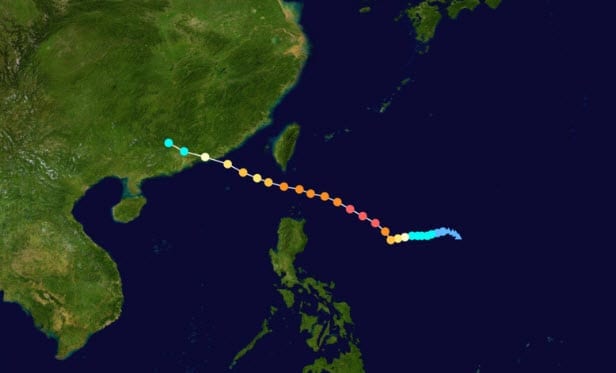According to catastrophe modeling firm AIR Worldwide, Severe Typhoon Usagi, the 19th named storm to form in the Northwest Pacific this year, made landfall near the city of Shanwei (150 kilometers northeast of Hong Kong) in the Chinese province of Guangdong at 6 p.m. (local time) Sunday. Accompanied by heavy rains, a central pressure of 941 millibars, and 10-minute sustained winds of 85 knots (157 km/h) according to the Japan Meteorological Agency (JMA), Usagi struck as a strong Category 2 typhoon. Prior to landfall, the Hong Kong Observatory raised the No. 8 storm warning signal—the third highest on a five-point scale— indicating winds of 63 km/h or more.
As of 1:00 a.m. HKT (local time) on Monday, Usagi has maximum sustained winds of 150 km/h. Its center is now located about 80 kilometers north of Hong Kong.
According to AIR, the storm weakened more than expected before landfall and has weakened considerably since. It is now at tropical storm strength. This morning it made its closest pass to Hong Kong, skirting within 100 km to the north of the territory. Hong Kong’s Lau Fau Shan observatory and Cheung Chau Island recorded sustained winds of 85 km/h and 67 km/h, respectively, at the time of closest approach. Because the storm made landfall east of the city, Hong Kong was on the weaker (left) side of the storm and thus avoided Usagi’s strongest winds and highest storm surge. The tide level at Quarry Bay reached 2.8 meters, which is only 0.6m above the normal tide level.
Due to strong steering, Usagi is moving west-northwest at a fast forward speed of 30 km/h, which is resulting in low to moderate rainfall accumulations on the order of 150–200 mm in parts of central Hong Kong, according to the Tropical Rainfall Measuring Mission (TRMM). Additionally, Usagi is a relatively small storm, with a 30 km eye and a precipitation shield measuring just 250-300 km from the center.
According to AIR, the storm is forecast to continue moving west-northwest through Guangdong Province and cross over into Guangxi province. Although Usagi continues to weaken, it has the potential to dump additional precipitation in low-lying areas of Guangxi province. Satellite images show that Usagi is weakening quickly as it moves inland, and the storm should dissipate over inland China by Tuesday.
According to AIR, before striking southern China, Ugasi lashed Taiwan with high winds and heavy rains. In advance of the storm’s arrival more than 3,000 residents were evacuated from flood-prone areas and mountainous regions in Taiwan. Usagi dumped as much as 70 centimeters of rain, triggering landslides in mountainous areas while coastal areas have been hit by swells, storm surge and high waves.

Shipping lanes between Guangdong province and Taiwan were also shut down. In southern China, Usagi caused the cancellation of hundreds of flights, school closings, and delayed the opening of Hong Kong’s stock exchange. Authorities in Guangdong initiated an emergency response plan for the province’s nuclear power plants, ordering the reactors at the Daya Bay nuclear power station northeast of Hong Kong to operate at a reduced load. Police in Shanwei ordered more than 8,000 fishing boats to return to port and more than 1,200 residents were evacuated to temporary shelters. China’s Agriculture Ministry had urged authorities in Fujian, Jiangxi and Guangdong provinces to harvest mature crops in advance of the storm’s arrival.
According to AIR, while the storm was one of the strongest to hit China this year, the typhoon fortunately steered away from metropolitan Hong Kong, where the highest concentration of insured properties is located. Given the relatively weak winds and moderate precipitation in populated areas, as well as the fast forward speed of the storm—which will limit the duration of damaging wind and rain in southern China and
significant insured losses are not expected from Usagi.
AIR will continue to monitor Typhoon Usagi and will provide additional information as events warrant.
